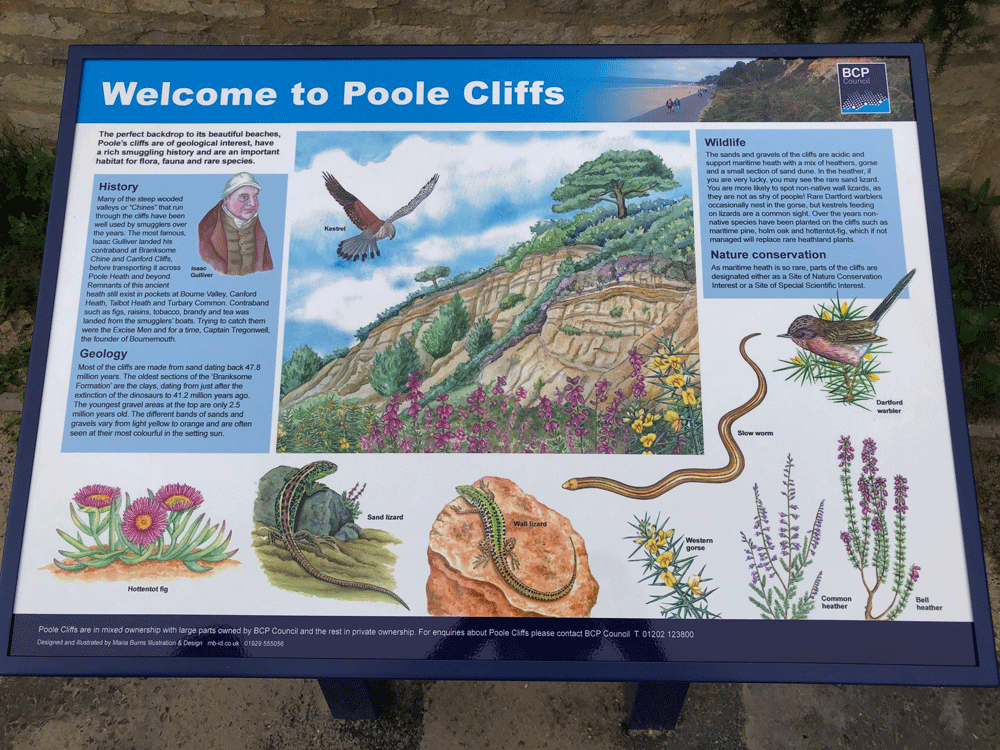
Human settlement in Poole dates back to before the Iron Age. The earliest recorded use of the town’s name was in the 12th century when the town began to emerge as an important port, prospering with the introduction of the wool trade. In later centuries the town had important trade links with North America and at its peak in the 18th century it was one of the busiest ports in Britain. During the Second World War, the town was one of the main departing points for the D-Day landings of the Normandy Invasion.
The town’s name derives from a corruption of the Celtic word bol and the Old English word pool meaning a place near a pool or creek.Variants include Pool, Pole, Poles, Poll, Polle, Polman, and Poolman. The area around modern Poole has been inhabited for the past 2,500 years. During the 3rd century BC, Celts known as the Durotriges moved from hilltop settlements at Maiden Castle and Badbury Rings to heathland around the River Frome and Poole Harbour. The Romans landed at Poole during their conquest of Britain in the 1st century and took over an Iron Age settlement at Hamworthy, an area just west of the modern town centre. In Anglo-Saxon times, Poole was included in the Kingdom of Wessex. The settlement was used as a base for fishing and the harbour a place for ships to anchor on their way to the River Frome and the important Anglo-Saxon town of Wareham. Poole experienced two large-scale Viking invasions during this era: in 876, Guthrum sailed his fleet through the harbour to attack Wareham, and in 1015, Canute began his conquest of England in PooleHarbour, using it as a base to raid and pillage Wessex.
Following the Norman conquest of England, Poole rapidly grew into a busy port as the importance of Wareham declined. The town was part of the manor of Canford, but does not exist as an identifiable entry in the Domesday Book. The earliest written mention of Poole occurred on a document from 1196 describing the newly built St James’s Chapel in “La Pole”. The Lord of the Manor, Sir William Longspée, sold a charter of liberties to the burgesses of Poole in 1248 to raise funds for his participation in the Seventh Crusade. Consequently, Poole gained a small measure of freedom from feudal rule and acquired the right to appoint a mayor and hold a court within town. Poole’s growing importance was recognised in 1433 when it was awarded staple port status by King Henry VI, enabling the port to begin exporting wool and in turn granting a licence for the construction of a town wall. In 1568, Poole gained further autonomy when it was granted legal independence from Dorset and made a county corporate by the Great Charter of Elizabeth I. During the English Civil War, Poole’s puritan stance and its merchants’ opposition to the ship money tax introduced by King Charles I led to the town declaring for Parliament. Poole escaped any large-scale attack and with the Royalists on the brink of defeat in 1646, the Parliamentary garrison from Poole laid siege to and captured the nearby Royalist stronghold at CorfeCastle.
Poole established successful commerce with the North American colonies in the 16th century, including the important fisheries of Newfoundland. The trade with Newfoundland grew steadily to meet the demand for fish from the Catholic countries of Europe. Poole’s share of this trade varied but the most prosperous period started in the early 18th century and lasted until the early 19th century. The trade was a three-cornered route; ships sailed to Newfoundland with salt and provisions, then carried dried and salted fish to Europe before returning to Poole with wine, olive oil, and salt. By the early 18th century Poole had more ships trading with North America than any other English port and vast wealth was brought to Poole’s merchants. This prosperity supported much of the development which now characterises the Old Town where many of the medieval buildings were replaced with Georgian mansions and terraced housing. The end of the Napoleonic Wars and the conclusion of the War of 1812 ended Britain’s monopoly over the Newfoundland fisheries and other nations took over services provided by Poole’s merchants at a lower cost. Poole’s Newfoundland trade rapidly declined and within a decade most merchants had ceased trading.
Poole Quay was the busy centre of the town’s maritime trade and the town grew rapidly during the industrial revolution as urbanisation took place and became an area of mercantile prosperity and overcrowded poverty. At the turn of the 19th century, nine out of ten workers were engaged in harbour activities, but as the century progressed ships became too large for the shallow harbour and the port lost business to the deep water ports at Liverpool, Southampton and Plymouth. Poole’s first railway station opened in Hamworthy in 1847 and later extended to the centre of Poole in 1872, effectively ending the port’s busy coastal shipping trade. The beaches and landscape of southern Dorset and south-west Hampshire began to attract tourists during the 19th century and the villages to the east of Poole began to grow and merge until the seaside resort of Bournemouth emerged. Although Poole did not become a resort like many of its neighbours, it continued to prosper as the rapid expansion of Bournemouth created a large demand for goods manufactured in Poole.
 Seaplanes and Flying Boats started using Poole Harbour around 1916 and you can read more about this and the days of Imperial Airways & BOAC at this fascinating website – Poole Flying Boats.
Seaplanes and Flying Boats started using Poole Harbour around 1916 and you can read more about this and the days of Imperial Airways & BOAC at this fascinating website – Poole Flying Boats.
During World War II, Poole was the third largest embarkation point for D-Day landings of Operation Overlord and afterwards served as a base for supplies to the allied forces in Europe. Eighty-one landing craft containing American troops from the 29th Infantry Division and the U.S. Army Rangers departed Poole Harbour for Omaha Beach. Poole was also an important centre for the development of Combined Operations and the base for a US Coast Guard rescue flotilla of 60 cutters. Much of the town suffered from German bombing during the war and years of neglect in the post-war economic decline. Major redevelopment projects began in the 1950s and 1960s and large areas of slum properties were demolished and replaced with modern public and facilities. Many of Poole’s historic buildings were demolished during this period, particularly in the Old Town area of Poole. Consequently, a 6-hectare (15-acre) Conservation Area was created in the town centre in 1975 to preserve Poole’s most notable buildings.
Courtesy Wikipedia
———————————————————————————————–
More recent times
Poole is a tourist resort, attracting visitors with its large natural harbour, history, the Lighthouse arts centre and Blue Flag beaches. The town has a busy commercial port with cross-Channel freight and passenger ferry services to Cherbourg and the Channel Islands. The headquarters of the Royal National Lifeboat Institution (RNLI) are located in Poole, and the Royal Marines have a base in the town’s harbour. Despite their names, Poole is the home of The Arts University Bournemouth, the Bournemouth Symphony Orchestra and a significant part of Bournemouth University.
It has to be said however that these days Poole’s town centre is rather run down. After walking through the Dolphin Centre (when it is open) visitors have to walk down the rather tacky pedestrianised ‘High Street’ before reaching the charming Old Town area with its fine selection of restaurants and pubs. The Quay is still the centre of most activity with the stunning boats of the Sunseeker boatyard occupying most of the far side. The Poole beach area east of Sandbanks includes Flaghead Chine, Canford Cliffs Chine, Branksome Chine and Branksome Dene Chine.
————————————————————————————————-
This article requires original content and updating, please help it grow.